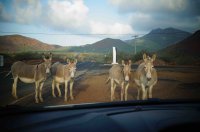Photos Jessica Brown
Wageningen students are keen travellers and often do internships in remote places. But few of them go as far (literally) as Jessica Brown from Australia. This Master’s student of Climate Studies is currently doing research on Ascension, an isolated island in the southern Atlantic, roughly half way between Brazil and Angola. Its closest ‘neighbouring country’ is about 1200 kilometres away: St Helena, the volcanic island that became famous when Napoleon was banished there.
Brown arrived on Ascension at the beginning of September on a British Royal Air Force plane that was making a stopover on its way to the Falkland Islands. Ascension is British too, forming a British Overseas Territory together with St. Helena and the even more remote Tristan de Cunha archipelago. The roughly 1000 residents are largely dependent on Great Britain for their food supply. ‘So it’s pretty hard to get fresh veggies,’ says Brown, ‘which is hard as I’m vegetarian!’
Forest fires
Brown is working on Ascension on an international project called Clarify-2016. There are two Dutch participants in this project: the royal meteorological institute KNMI and the Technical University of Delft. Clarify researches the impact of forest fires on cloud formation. The droplets of which clouds are made up never form entirely spontaneously, not even if the air contains enough condensation and is cold enough. A nucleus is needed: a grain of sand or a flake of ash, for instance, on which water condensates. The project scientists monitor this process using measurements taken from satellites, the ground and planes. They want to gain a better understanding of the effect of smoke, because it is a relatively poorly understood aspect of our climate. ‘Clouds are very difficult to incorporate into climate models,’ says Brown, ‘and smoke changes how clouds develop.’ Particles –aerosols, to use the technical term – stimulate cloud formation. As the number of particles in the air increases, more and smaller condensation droplets are formed, influencing in turn how the resulting cloud scatters the light and how much energy is absorbed.
Volcanic
Ascension is a good place to study this process. ‘Mainly because there is plenty of both: lots of smoke and lots of clouds.’ This is due to the volcanic island’s position. Cold ocean water surfaces here, making for a relatively cold and humid atmosphere. Meanwhile, a lot of ash drifts over the sea from the African continent, where there are frequent forest fires in the dry season. ‘This island is often described as a natural laboratory.’

Brown herself takes ground measurements. She has set up a LiDAR sensor, a kind of radar system which uses laser light instead of radio waves. The degree to which laser light is scattered shows how many particles there are in the air. For the next three weeks Brown has to make sure the gadget continues to measure correctly. Meanwhile she is already analysing the data and working on her report.
This island is often described as a natural laboratory
When she’s not working on these tasks, Brown has plenty of time to explore the island on foot. Ascension is rugged and shows many signs of geological activity. ‘It’s a very strange landscape here, says Brown, ‘sometime I feel like I’m on the moon.’ In the middle of the island there is a single mountain, planted with a small area of tropical forest. Originally the island was completely bare but the idea was that the tropical plants would help retain water.
Sharks
Initially Brown was planning to go diving. ‘There are a lot of fish here.’ Since seeing six Galapagos sharks of two and a half metres long ripping fish apart in a feeding frenzy, she has had second thoughts. So far, she has not been troubled by the quiet or by loneliness. The hotel where she is staying, mainly used by people coming who come to this exotic destination to fish or dive, only has one other guest. There are no other scientists here at the moment. ‘I have lots of time to work on my report without distractions,’ Brown jokes. Would she spend six months here? ‘Maybe if I took up fishing. But no, I think one month is enough.’
*Test rocket with three mice
Between 1967 and the mid-1990s, the American space organization NASA had a tracking station for rockets on Ascension, described by the German writer Judith Schalansky in the Atlas of remote islands. Even before that, in 1960, the nose cone of an intercontinental test rocket landed close to the island. The three black mice inside it survived. ‘In good condition.’
